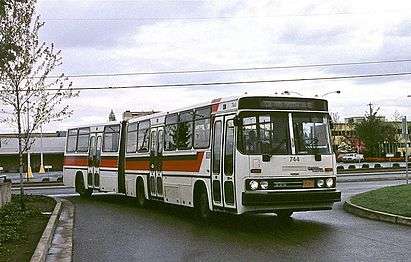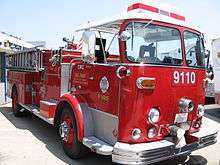Crown Coach Corporation
 | |
| Industry | Transportation |
|---|---|
| Fate | Defunct |
| Founded | Los Angeles, California (1904) |
| Founder | D. Brockway |
| Defunct | March 1991 |
| Headquarters |
Los Angeles, California (1904-1985) Chino, California (1985-1991) |
Area served | West Coast, United States |
| Products |
School Buses Fire Apparatus |
| Parent | GE Railcar (1987-1991) |
The Crown Coach Corporation (founded as the Crown Carriage Company) is a defunct American bus manufacturer. Established in 1904, Crown was headquartered in Los Angeles, California until the mid-1980s, moving to Chino, California until its closure. Best known for its Supercoach school buses, the company also produced motorcoaches and various fire apparatus.[1][2]
Crown closed in March 1991 due to declining demand for school buses at the time.[3][4] At the time of its closure, Crown Coach was a subsidiary of GE Railcar.
History
1904-1920: Wagons to school buses
At the beginning of the 20th century, Don M. Brockway found himself working at the first hardware store in Los Angeles, California;[2] to supplement its income, the hardware store also sold parts for wagons and carriages[1] In 1904, Brockway founded Crown Carriage Company, producing purpose-built horse-drawn carriages. While the first vehicles were built in a wooden shed, the company moved to a brick factory in 1910.[2]
After 1910, as carriages gradually became "horseless", Crown experimented with building truck bodies. In 1916, the company built its first bus body for transit use; it was an open-air design heavily influenced by wagon design.[2] After World War I, Crown built its first body for school bus use.[1][2]
1921-1945: Metal bodies and Supercoaches
In 1921, a major shift in company production occurred as Murillo M. ("Brock") Brockway, the son of the company founder, was put in charge of school bus production.[2] Viewing school buses as a growth market in the suburbs of southern California, Brockway discontinued all wagon production in favor of bus and truck body production. To expand production and improve shipping of its vehicles, a much larger factory in Los Angeles was opened in 1923.[1]
In pursuit of developing heavier-duty and higher-capacity school buses, Crown introduced the first school bus with dual rear wheels in 1927. In 1930, it produced its first all-metal school bus body (on a Mack chassis), with a 43-passenger capacity.[2]
1932 would mark several major changes for the company. As part of his taking over day-to-day operations of Crown from his father, MM Brockway introduced a ground-breaking school bus body; elements of its design would change school bus design forever. To improve forward visibility, the new bus was a cab-forward design, with the driver sitting next to the engine and radiator.[2] To improve safety, the bus was designed with an integral chassis; the windows were mesh-reinforced safety glass.[2] Alongside the standard braking system, the bus also was equipped with two backup braking systems.[1] In 1935, the cab-forward school bus was updated and dubbed the Crown Supercoach.
For 1937, to increase seating capacity to 79 passengers, Crown produced its first mid-engine Supercoach; the bus came with a Hall-Scott gasoline engine.[2] In 1939, Crown acquired Moreland Motor Truck Company; as part of the acquisition, Crown moved to a larger factory in Los Angeles.[1] Additionally, the Supercoach was changed from a mid-engine to a rear-engine configuration for 1940.[2]
1950-1980: Mid-engine school buses
In the United States during the years immediately following World War II, population growth of suburbs expanded, fueled by the post-war baby boom. As that segment of the population entered school, demand for new schools (and school buses to transport them) rapidly rose. In 1946, Crown began development on a new mid-engine Supercoach. Heavily influenced by motorcoach design, Crown intended it primarily for school bus use. Introduced in 1949, the all-new Supercoach used unit-body construction with high-strength steel in place of a separate chassis; to combat corrosion, all body panels were aluminum.
To prove the durability of the Supercoach to potential customers, Crown sold the vehicle with a 20-year/100,000 mile warranty for the body.[1]
During the mid-1950s, several changes were made to the Supercoach. In 1954, the Cummins NHH diesel engine was added as an option, becoming the first diesel-powered Supercoach. A year later, the tandem-rear axle Supercoach made its debut; the largest school bus of its time, it seated as many as 91 passengers.[2]
From the 1950s to the 1970s, the Crown Supercoach and the similar Gillig Transit Coach became two of the most common school buses on the West Coast of the United States. Although conventional-type school buses remained in demand, the development costs did not justify starting an all-new model line. To supplement its income, Crown served as the West Coast distributor for other manufacturers, including Wayne, Blue Bird, and Thomas Built Buses; Crown also marketed Prevost motorcoaches alongside its own coach buses.
1980-1991: Decline
In 1979, the Brockway family sold Crown Coach Corporation to a local truck distributor; this began a sequence of ownership changes.[1] During 1984, Crown moved from Los Angeles to Chino, California in San Bernardino County. To diversify beyond school buses, Crown entered into a joint venture with the Hungarian firm Ikarus to produce articulated mass-transit buses. The Crown-Ikarus 286 was bodied in Hungary, with final assembly by Crown in California, with the fitments of American-sourced powertrains and interiors. In 1986, the partnership ended, with 243 buses produced.
By the end of the 1980s, the Supercoach had been in production with only minor changes for nearly 40 years. As Crown prepared the Supercoach to use a methanol-fueled version of the Detroit Diesel 6V92, major changes to the bodyshell were necessitated. The rear-mounted engine required new rear bodywork, which forced a complete change to front body. Although not an all-new design, the Series II, as it was named, was the first major update to the Supercoach since 1948.
After its acquisition, operation ceased in 1991. Crown's difficulty in competing with manufacturers of smaller, less durable but cheaper school buses was cited by company president Bruce Freeman in October 1990 as a primary factor in GE's decision to leave the school bus market.[4]
Products
Bus
The primary product line of Crown Coach, several configurations of buses were sold by the company. In 1949, Crown introduced a redesigned Supercoach; initially designed to replace its motorcoach line, the Supercoach became one of the most popular school buses of the West Coast.
Pre-war
- Crown Model B-3
- Crown Model D
Motorcoach
- Motorcoach/Tourcoach
- Highway Coaches
- Intercity Coaches
School buses

Two years after building its first school bus, Crown built the first factory-designed forward-control school bus. Redesigned in 1948 after World War II, the Crown Supercoach was the only school bus in North America built with monoque construction in place of a separate frame. Along with the Gillig Transit Coach, the Crown Supercoach is the only school bus built with a mid-engine layout; it is also among the heaviest school buses ever built. From 1948 to 1991, the Supercoach was produced in nearly the same body style, with several minor updates.
The Crown Supercoach Series II is a variant of the Supercoach built from 1989 to 1991. Originally updated to accommodate a methanol-fueled Detroit Diesel 6V92 engine, the Series II features different front and rear bodywork from its predecessor, along with a redesigned drivers' compartment.
Transit buses

In the mass transit segment, Crown served largely as a partner to other manufacturers in place of developing its own designs. Following World War II, Crown sold and marketed the Ford Transit Bus. From 1961 to 1962, the Coachette City Bus was built by Crown.
Following the end of the production of the GM and Flxible "New Look" buses at the end of the 1970s, in order to enter the mass-transit segment, Crown entered a partnership with Hungarian bus manufacturer Ikarus. One of the first articulated buses to come into use into the United States, the Crown-Ikarus 286 was a modified version of the Ikarus 280; Crown Coach fitted the Ikarus bodyshells with American interiors and powertrains.
After only 243 were produced from 1980 to 1986, production of the Crown-Ikarus was discontinued, though Ikarus would continue North American bus production with Orion, leading to the Orion III.
Fire apparatus

During World War II, the production of Crown Coach was diverted towards military use; most bodies produced by the company were fire engine bodies for four-wheel drive truck chassis.[5] Following the war, the company returned to bus production,.beginning design work on the 1948 Supercoach. As a side project, engineers at the company designed an all-new cabover fire engine, using the mid-engine chassis of the Supercoach bus.[2] The first Crown Firecoach prototype was completed in 1951, after two years of design work.[2]
While sold primarily across the West Coast, the Crown Firecoach would be purchased by fire departments across the United States.[2] Alongside the initial pumper design, Crown produced the Firecoach in several configurations, including water tenders, tiller and ladder trucks, and quints (TeleSquirts).
On television, two active Crown Firecoaches of the Los Angeles County Fire Department (LACoFD) were featured on the NBC/Universal television series Emergency!.[6][7][8][9][10]
The Firecoach was produced with only gradual changes over its production run; after 1965, a roof was made standard for all Firecoaches. By the end of the 1970s, the design was aging in comparison to other firefighting vehicles, so Crown discontinued production of the Firecoach in 1982 to concentrate on buses. After a brief production revival in 1984-1985, the Firecoach line was permanently discontinued;[5] approximately 1800 were produced in total.[2]
Other Products
Specialty vehicles
- Security Jail Coaches 1950s — 35-foot and 40-foot chassis; 42-64 passengers
- Mobile Command unit/Crown Coach HPO Bookmobile for Apple Valley
Trucks
- Truck cabs and bodies 1910s
- Federal truck chassis
Aircraft
Crown made aircraft from 1925 to 1933.
External links
- Crown Coach Historical Society - founded by Sandi Brockway
- Bruce Vanderhorst Crown Fire Engine Website
- Paul Krot's Crown Firecoach Photo Archive
- Chris Arnolds Crown Firecoach Website
References
- 1 2 3 4 5 6 7 8 Mark Theobald (2004). "Crown Coach". Coachbuilt.com. Retrieved 2010-04-29
- 1 2 3 4 5 6 7 8 9 10 11 12 13 14 15 16 Hass, Ed. "The Dentist Who Built Buses and Fire Engines by Ed Hass". Retrieved 27 October 2014.
- ↑ J. H. Velentine. "Crown Coach: California's Speciality Builder". Tripod. Retrieved 2010-04-27.
- 1 2 Sandi Brockway (September 8, 2010) "School Bus Maker Crown Coach to Close Next March," George White. October 12, 1990. Crown Coach Historical Society. Retrieved 2014-03-20
- 1 2 "techtimeline". www.crownisking.org. Retrieved 2016-06-25.
- ↑
- ↑ Los Angeles County Fire Museum Collection - 1965 Crown Firecoach
- ↑ Visit the County Of Los Angeles Fire Museum Archived January 30, 2013, at the Wayback Machine.
- ↑ "Engine 51 Restoration". LA County Fire Museum, Inc. Retrieved 25 May 2013.
- ↑ County Of Los Angeles Fire Museum's Engine 51 Ward LaFrance